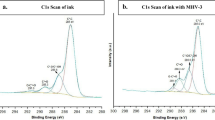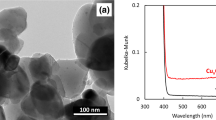Abstract
The infectivity of the H9N2 virus to MDCK cells was time-dependently inhibited by Cu2+ at concentrations of 2.5–250 μM. In 25 μM Cu2+ solution, the virus titer decreased by approximately 3 and 4 log within 3 and 6 h, respectively. Compared to Cu2+, Zn2+ was much less effective in virus inactivation. The H9N2 virus hemagglutinin activity was not affected by 2.5–250 μM Cu2+. The H9N2 virus neuraminidase (NA) activity was drastically reduced by 25 mM Cu2+, marginally reduced by 250 μM Cu2+, and not affected by 25 μM Cu2+. Thus, we found that copper ions suppress the infectivity of influenza virus at lower concentrations at which neither NA nor hemagglutination inhibition occurs. Electron microscopic analysis revealed morphological abnormalities of the Cu2+-treated H9N2 virus. Additional studies should be undertaken to clarify the mechanism underlying the antiviral effect of copper ions on influenza virus.





Similar content being viewed by others
References
Aruoma OI, Halliwell B, Gajewski E, Dizdaroglu M (1991) Copper-ion-dependent damage to the bases in DNA in the presence of hydrogen peroxide. Biochem J 273:601–604
Borkow G, Gabbay J (2005) Copper as a biocidal tool. Curr Med Chem 12:2163–2175
Dizdaroglu M, Rao G, Halliwell B, Gajewski E (1991) Damage to the DNA bases in mammalian chromatin by hydrogen peroxide in the presence of ferric and cupric ions. Arch Biochem Biophys 285:317–324
Evans GW (1973) Copper homeostasis in the mammalian system. Physiol Rev 53:535–570
Ewing HP, Pesti GM, Bakalli RI, Menten JFM (1998) Studies on the feeding of cupric sulfate pentahydrate, cupric citrate, and copper oxychloride to broiler chickens. Poult Sci 77:445–448
Howe C, Morgan C (1969) Interactions between Sendai virus and human erythrocytes. J Virol 3:70–81
Karlström AR, Levine RL (1991) Copper inhibits the protease from human immunodeficiency virus 1 by both cysteine-dependent and cysteine-independent mechanisms. Proc Natl Acad Sci USA 88:5552–5556
Kopitz J, von Reitzenstein C, Mühl C, Cantz M (1994) Role of plasma membrane ganglioside sialidase of human neuroblastoma cells in growth control and differentiation. Biochem Biophys Res Commun 30:1188–1193
Levinson W, Faras A, Woodson B, Jackson J, Bishop JM (1973) Inhibition of RNA-dependent DNA polymerase of Rous sarcoma virus by thiosemicarbazones and several cations. Proc Natl Acad Sci USA 70:164–168
Miles RD, O’Keefe SF, Henry PR, Ammerman CB, Luo XG (1998) The effect of dietary supplementation with copper sulfate or tribasic copper chloride on broiler performance, relative copper bioavailability, and dietary prooxidant activity. Poult Sci 77:416–425
Miyagi T, Hata K, Hasegawa A, Aoyagi T (1993) Differential effect of various inhibitors on four types of rat sialidase. Glycoconj J 10:45–49
Nackerdien Z, Rao G, Cacciuttolo MA, Gajewski E, Dizdaroglu M (1991) Chemical nature of DNA-protein cross-links produced in mammalian chromatin by hydrogen peroxide in the presence of iron or copper ions. Biochemistry 30:4873–4879
Noyce JO, Michels H, Keevil CW (2007) Inactivation of influenza A virus on copper versus stainless steel surfaces. Appl Environ Microbiol 73:2748–2750
Rafelson ME, Schneir M, Wilson VW (1963) Studies on the neuraminidase of influenza virus. II. Additional properties of the enzymes from the Asian and PR 8 strains. Arch Biochem Biophys 103:424–430
Rifkind JM, Shin YA, Heim JM, Eichhorn GL (1976) Cooperative disordering of single-stranded polynucleotides thorough copper crosslinking. Biopolymers 15:1879–1902
Sagripanti JL, Goering PL, Lamanna A (1991) Interaction of copper with DNA and antagonism by other metals. Toxicol Appl Pharamcol 110:477–485
Sagripanti JL, Kraemer KH (1989) Site-specific oxidative DNA damage at polyguanosines produced by copper plus hydrogen peroxide. J Biol Chem 264:1729–1734
Sagripanti JL, Lightfoote MM (1996) Cupric and ferric ions inactivate HIV. AIDS Res Hum Retroviruses 12:333–337
Sagripanti JL, Routson LB, Bonifacino AC, Lytle CD (1997) Mechanism of copper-mediated inactivation of herpes simplex virus. Antimicrob Agents Chemother 41:812–817
Sagripanti JL, Routson LB, Lytle CD (1993) Virus inactivation by copper or iron ions alone and in the presence of peroxide. Appl Environ Microbiol 59:4374–4376
Toyokuni S, Sagripanti JL (1996) Association between 8-hydroxy-2′-deoxyguanosine formation and DNA strand breaks mediated by copper and iron. Free Radic Biol Med 20:859–864
Tulsiani DRP, Carubelli R (1970) Studies on the soluble and lysosomal neuraminidases of rat liver. J Biol Chem 245:1821–1827
United States Environmental Protection Agency. Public drinking water system. Available from http://www.epa.gov. Accessed 5 April 2008
Yohe HC, Rosenberg A (1978) Effect of neurotoxic divalent cations on the activity of the intrinsic nerve ending membrane-associated sialidase of bovine brain. Neurochem Res 3:101–113
Acknowledgments
This work was partially supported by grants from the Program of Founding Research Centers for Emerging and Reemerging Infectious Diseases, and by grant-in aid for Exploratory Research (19659115), MEXT Japan.
Author information
Authors and Affiliations
Corresponding author
Rights and permissions
About this article
Cite this article
Horie, M., Ogawa, H., Yoshida, Y. et al. Inactivation and morphological changes of avian influenza virus by copper ions. Arch Virol 153, 1467–1472 (2008). https://doi.org/10.1007/s00705-008-0154-2
Received:
Accepted:
Published:
Issue Date:
DOI: https://doi.org/10.1007/s00705-008-0154-2




